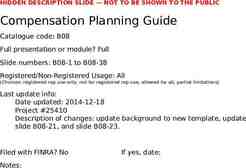DCML: Use Cases in IT Service Management J. Darrel Thomas Chief
27 Slides1.47 MB
DCML: Use Cases in IT Service Management J. Darrel Thomas Chief Technologist, Hosting Electronic Data Systems Corporation
Data Center Markup Language (DCML) The only open, XML-based standard designed to achieve interoperability by providing a systematic, vendor-neutral way to describe an IT Service environment Universal language that describes elemental, process, and service-oriented relationships between IT service entities and policies governing the management of such environments Handles heterogeneous and semantic information required to manage at the service level 2003-2005 DCML Member Section, All Rights Reserved
The Problem DCML Helps Solve IT Services Management requires a multidimensional approach Mapping of interdependencies and interrelationships at the elemental, process, and services level does not currently exist Complex, heterogeneous environments require interchange standardization between management systems DCML helps bridge this disparity using ontological and “like” meta-relationships 2003-2005 DCML Member Section, All Rights Reserved
IT Services Management Standardization Has Varying Domain-Based Initiatives to Address Its Dimensions Many standards have been or are being developed to address the INDIVIDUAL DOMAIN issues Service Desk (ITIL, COBIT, BS15000, CMMI) IT Process Frameworks & Standards Incident Problem Release Business Application Industry IT Foundation Process (.NET, Java, SOA (MDA, HIPPA, etc.) (LDAP, SMTP, etc) (BPEL, ebXML) WS, UDDI, etc.) Etc. Service-Oriented Change IT Integral Packaging (OGSA/I, etc.) Configuration Service Level Financial Capacity Continuity IT Domain-Specific Elemental Servers (CIM-SMASH) IPMI WS-* Storage Purposeful Operating Network Applications (CIM-SMIS) Infrastructure Systems (CIM) (CIM?) WS-* (WSDM2.0, WS-*) (CIM-SMASH) WSDM2.0, WS-*WSDM2.0/WS-* Availability 2003-2005 DCML Member Section, All Rights Reserved Interface Elemental
But, There is STILL Confusion with Possibly The Most Import IT Services Dimension – Interrelationships, Configurations, and Dependencies This area still looms as the enterprise/service provider’s most important inhibitor for standardizing IT Services Management. Assistance? Un/Planned Events? IT Process Frameworks Crises? Business Process Application Industry Infrastructure Service-Oriented Etc. Production-ize? Adjustments? Relationships? Service-to-Element Relationship Intelligence Elemental Relationships Operational Intelligence Guarantees? Service Dynamics Process Dynamics IT Domain/Element Relational IT Integral Packaging Elemental Relationship Intelligence ? IT Domain-Specific Elemental Resourcing? Servers Recovery? Storage Purposeful Infrastructure Operating Systems Network Accessibility? 2003-2005 DCML Member Section, All Rights Reserved Applications Interface Elemental
DCML Enables IT As A Service Employees 2003-2005 DCML Member Section, All Rights Reserved
Process Use Case: Instrumenting ITIL’s CMDB Problem Statement The Information Technology Infrastructure Library is a process-oriented framework expressing the best practices and components of IT Service Management and how to implement it. Customers require implementations of ITIL, and disparity in the ways in which it is implemented inhibits rapid standardization and adoption. DCML proposes to electronically instantiate the key relational aspects of the primary interdependency and relational process of ITIL, Configuration Management, as well as further instrumenting the process relationships that are iteratively used in the ITIL framework according to expected, patterned, and natural interactions. 2003-2005 DCML Member Section, All Rights Reserved
Process Use Case: Instrumenting ITIL’s CMDB Success Criteria Prospective enterprises looking to implement standardized operational models that use the ITIL framework directly use DCML to build Configuration Items (CIs) within their Configuration Management Database (CMDB), as well as roadmap all IT elements from a company’s ITIL-framed Definitive Software Library (DSL) and Definitive Hardware Store (DHS) DCML would be used to create the data model and relationship schema for the DHS, DSL, and CI/CMDB entities of ITIL DCML would also instrument standardized relationship mappings between ITIL processes, specifying their natural invocations as services are run across them. 2003-2005 DCML Member Section, All Rights Reserved
Process Use Case: Instrumenting ITIL’s CMDB Solution Overview Prospective enterprise develops CMDB, uses DCML’s schema and data model to create interrelated CIs for CMDB CMDB stores CI with relationship mappings between DHS and DSL components, as well as interfaces, attributes, and parameters to create running services, systems inter-ITIL process communications. Operational Model includes orchestration of CMDB-DCML components via management tooling and integration framework Enterprise uses DCML’s meta-mapping of other elemental standards to gather elemental component characteristics and relate them to services and processes with integrations Enterprise uses DCML to standardize the mapping of its existing and new resources into its relational/interdependent CMDB and operational model. 2003-2005 DCML Member Section, All Rights Reserved
Transformation Use Case: Discovering Configurations for CMDB Population Problem Statement Outsourcers need to be able to discover existing configurations in order to enable transformation and standardization of enterprises to emerging IT technologies and paradigm changes. In order to accomplish the task, tools or methods of relationship, interdependency, elemental/resource usage, and existing processes and workflows must be derived. DCML’s configuration/relationship mapping characteristics are ideal to be implemented in either tooling or operational processes to obtain relational information and existing 2003-2005 DCML Member Section, All Rights Reserved
Transformation Use Case: Discovering Configurations for CMDB Population Success Criteria Prospective enterprises looking to implement standardized operational models that use the ITIL framework directly use DCML to build Configuration Items (CIs) within their Configuration Management Database (CMDB), as well as roadmap all IT elements from a company’s ITIL-framed Definitive Software Library (DSL) and Definitive Hardware Store (DHS) DCML would be used to create the data model and relationship schema for the DHS, DSL, and CI/CMDB entities of ITIL DCML would also instrument standardized relationship mappings between ITIL processes, specifying their natural invocations as services are run across them. 2003-2005 DCML Member Section, All Rights Reserved
Transformation Use Case: Discovering Configurations for CMDB Population Solution Overview Prospective enterprise develops CMDB, uses DCML’s schema and data model to create interrelated CIs for CMDB CMDB stores CI with relationship mappings between DHS and DSL components, as well as interfaces, attributes, and parameters to create running services, systems inter-ITIL process communications. Operational Model includes orchestration of CMDB-DCML components via management tooling and integration framework Enterprise uses DCML’s meta-mapping of other elemental standards to gather elemental component characteristics and relate them to services and processes with integrations Enterprise uses DCML to standardize the mapping of its existing and new resources into its relational/interdependent CMDB and operational model. 2003-2005 DCML Member Section, All Rights Reserved
Service Oriented Use Case: Instantiating SOA Thru DCML and IT Services Management Problem Statement Outsourcers need to be able to discover existing configurations in order to enable transformation and standardization of enterprises to emerging IT technologies and paradigm changes. In order to accomplish the task, tools or methods of relationship, interdependency, elemental/resource usage, and existing processes and workflows must be derived. DCML’s configuration/relationship mapping characteristics are ideal to be implemented in either tooling or operational processes to obtain relational information and existing 2003-2005 DCML Member Section, All Rights Reserved
Transformation Use Case: Discovering Configurations for CMDB Population Success Criteria Prospective enterprises looking to implement standardized operational models that use the ITIL framework directly use DCML to build Configuration Items (CIs) within their Configuration Management Database (CMDB), as well as roadmap all IT elements from a company’s ITIL-framed Definitive Software Library (DSL) and Definitive Hardware Store (DHS) DCML would be used to create the data model and relationship schema for the DHS, DSL, and CI/CMDB entities of ITIL DCML would also instrument standardized relationship mappings between ITIL processes, specifying their natural invocations as services are run across them. 2003-2005 DCML Member Section, All Rights Reserved
Transformation Use Case: Discovering Configurations for CMDB Population Solution Overview Prospective enterprise develops CMDB, uses DCML’s schema and data model to create interrelated CIs for CMDB CMDB stores CI with relationship mappings between DHS and DSL components, as well as interfaces, attributes, and parameters to create running services, systems inter-ITIL process communications. Operational Model includes orchestration of CMDB-DCML components via management tooling and integration framework Enterprise uses DCML’s meta-mapping of other elemental standards to gather elemental component characteristics and relate them to services and processes with integrations Enterprise uses DCML to standardize the mapping of its existing and new resources into its relational/interdependent CMDB and operational model. 2003-2005 DCML Member Section, All Rights Reserved
Interoperability Use Case: Metamapping DCML and SDM Through Developmental Modeling Problem Statement Outsourcers need to be able to discover existing configurations in order to enable transformation and standardization of enterprises to emerging IT technologies and paradigm changes. In order to accomplish the task, tools or methods of relationship, interdependency, elemental/resource usage, and existing processes and workflows must be derived. DCML’s configuration/relationship mapping characteristics are ideal to be implemented in either tooling or operational processes to obtain relational information and existing 2003-2005 DCML Member Section, All Rights Reserved
Interoperability Use Case: Metamapping DCML and SDM Through Developmental Modeling Success Criteria Prospective enterprises looking to implement standardized operational models that use the ITIL framework directly use DCML to build Configuration Items (CIs) within their Configuration Management Database (CMDB), as well as roadmap all IT elements from a company’s ITIL-framed Definitive Software Library (DSL) and Definitive Hardware Store (DHS) DCML would be used to create the data model and relationship schema for the DHS, DSL, and CI/CMDB entities of ITIL DCML would also instrument standardized relationship mappings between ITIL processes, specifying their natural invocations as services are run across them. 2003-2005 DCML Member Section, All Rights Reserved
Interoperability Use Case: Metamapping DCML and SDM Through Developmental Modeling Solution Overview Prospective enterprise develops CMDB, uses DCML’s schema and data model to create interrelated CIs for CMDB CMDB stores CI with relationship mappings between DHS and DSL components, as well as interfaces, attributes, and parameters to create running services, systems inter-ITIL process communications. Operational Model includes orchestration of CMDB-DCML components via management tooling and integration framework Enterprise uses DCML’s meta-mapping of other elemental standards to gather elemental component characteristics and relate them to services and processes with integrations Enterprise uses DCML to standardize the mapping of its existing and new resources into its relational/interdependent CMDB and operational model. 2003-2005 DCML Member Section, All Rights Reserved
Model-Based Management Knowledge drives management System Definition Model: a modeling language that is used to capture a formal model of a system Includes all information pertinent to deployment and ongoing operations 2003-2005 DCML Member Section, All Rights Reserved
SDM Concepts The boxes: systems, subsystems, components The lines: relationships 1. Containment with rich compositing semantics 2. Hosting with specific semantics 3. Several types of communication and dependency Œ Ž An extensible class hierarchy 2003-2005 DCML Member Section, All Rights Reserved e l b i s Exten
Domain-Specific Knowledge Model contains “all information pertinent to deployment and operations” System topology Developer constraints IT policy Installation directives Health model Monitoring rules Service Level Agreements Reports 2003-2005 DCML Member Section, All Rights Reserved e l b i s Exten
Applications of Model Provisioning of distributed systems Desired configuration management Health monitoring, root cause analysis, impact analysis End-to-end service level management Capacity planning VM and workload management 2003-2005 DCML Member Section, All Rights Reserved e l b i s Exten
Scale of Model Hardware components inside a computer Applications and server roles in one computer Server farm Distributed service Services across trust domains 2003-2005 DCML Member Section, All Rights Reserved
Sources of Model and Policy Information Development environment (Visual Studio) IT staff through management tools Discovery Operational Monitoring Error reporting Model lives in XML manifest, travels with application 2003-2005 DCML Member Section, All Rights Reserved e l b i s Exten
SDM and DCML DSI and SDM are broad platform initiatives Modeling framework Development tools Stores, replication systems Integration in the whole stack (SW and HW) Management systems A platform for the ecosystem DCML is a heterogeneous inter-relationship mapping and representation format Interchange format IT Services CMDB standardization specification and heterogeneous dynamically updated model representation – both discovery-based and preinstantiated Multi-dimensional relationship and interface mapping between other standards and models (including feeds to other upper layer standards and initiatives) 2003-2005 DCML Member Section, All Rights Reserved
Thank You! QUESTIONS AND ANSWERS Adobe Acrobat 7.0 Document 2003-2005 DCML Member Section, All Rights Reserved
































